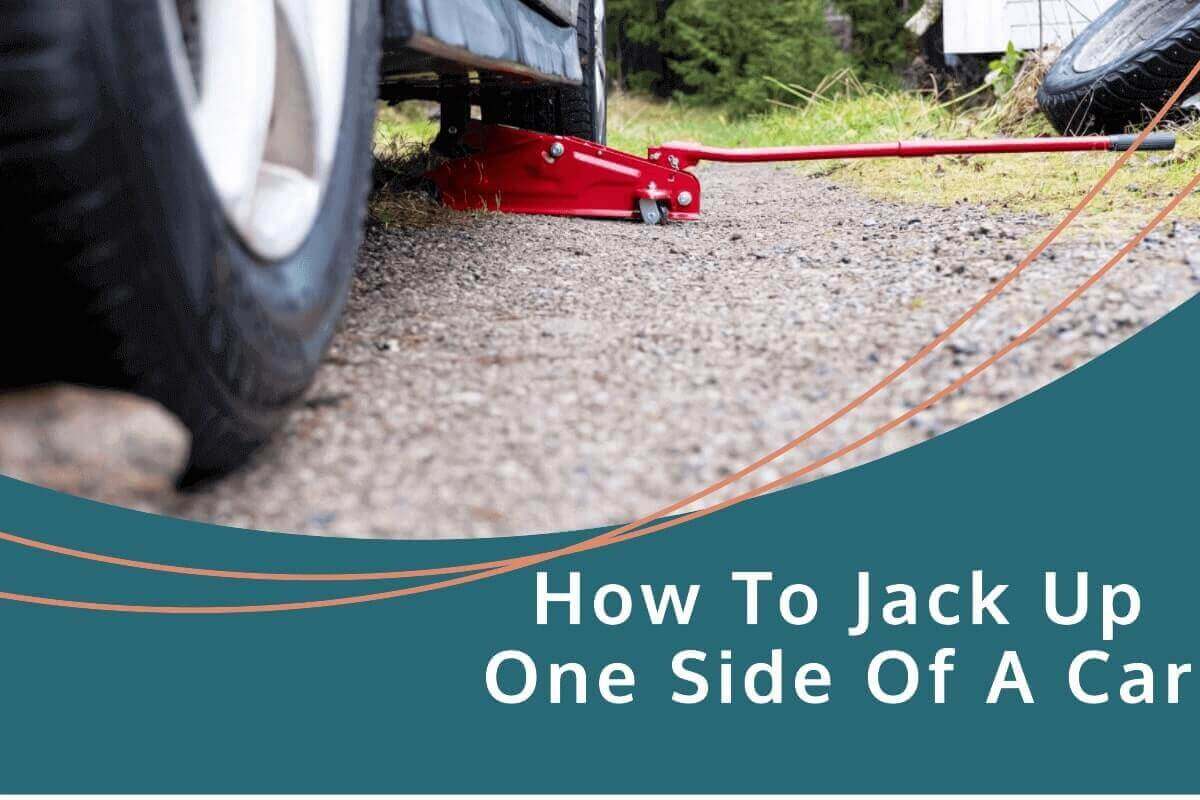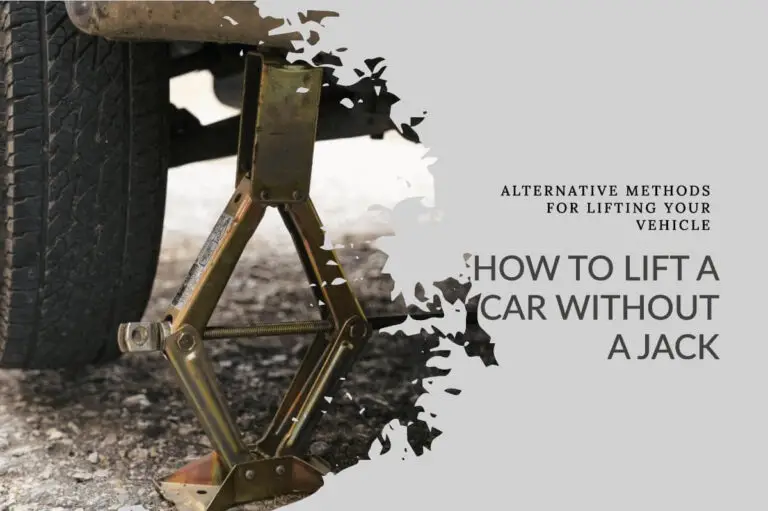Whether you’re a car enthusiast or someone who wants to perform essential maintenance on your vehicle, knowing how to jack up one side of a car safely is critical. This step-by-step guide will walk you through the process in a beginner-friendly manner, ensuring both your safety and the integrity of your vehicle.
How to Jack Up One Side of a Car Safely
Before you start lifting your car, it’s crucial to comprehend why you might need to do this. Jacking up one side of a car is commonly done for tasks like changing a flat tire, inspecting brakes, or performing oil changes.
Properly lifting the vehicle prevents strain on the suspension and ensures you have enough space to work comfortably. Let’s get started to answer how to jack up one side of a car.
Gather Your Tools and Equipment
Before you begin, gather the necessary tools and equipment to ensure a smooth and safe process. Here’s what you’ll need:
- Floor Jack: Choose a sturdy, automotive-rated floor jack that can handle the weight of your vehicle.
- Jack Stands: Get a pair of jack stands with a weight capacity that matches your vehicle’s weight.
- Wheel Chocks: These prevent the car from rolling while it’s lifted.
- Lug Wrench: Necessary for loosening and tightening lug nuts.
- Work Gloves: Protect your hands from dirt and potentially sharp edges.
- Owner’s Manual: Consult your vehicle for specific jacking points and guidelines.
Finding the Proper Location
Identifying the right location to jack up your car is crucial for your safety and the vehicle’s stability. Follow these steps:
- Park on a Level Surface: Choose a flat, stable surface to avoid unwanted shifting.
- Engage the Parking Brake: Prevent the car from moving by engaging the parking brake.
- Check the Opposite Wheels: Place wheel chocks behind the wheels opposite to the side you’re lifting.
Lifting the Car
Now, let’s proceed with safely lifting your car:
- Locate the Jacking Point: Consult your owner’s manual to find the designated jacking point for your vehicle. Common jacking points include the reinforced areas behind the front wheels and in front of the rear wheels.
- Position the Floor Jack: Slide the jack under the jacking point and properly align it. Pump the jack handle to lift the car slightly off the ground.
- Place the Jack Stands: Position the jack stands under the reinforced support points once the car is lifted. Slowly lower the car onto the jack stands.
- Double-Check Stability: Gently shake the car to ensure it’s secure on the jack stands. You should feel minimal movement.
Performing the Task
With the car safely lifted, you can now proceed with your maintenance task:
- Work Methodically: Follow a systematic approach to change a tire or inspect brakes. Avoid rushing and stay organized.
- Stay Safe: Keep your body parts clear of any potential pinch points or moving components.
- Use Proper Tools: Always use the right tools to prevent damage to your car and ensure accurate work.
Lowering the Car
Once you’ve completed the task, it’s time to lower the car safely:
- Clear the Area: Double-check that all your tools are clear of the vehicle.
- Position the Floor Jack: Place the floor jack back under the jacking point.
- Lift Slightly: Raise the car just enough to remove the jack stands safely.
- Remove Jack Stands: Carefully remove the jack stands and set them aside.
- Lower the Car: Slowly lower the car using the floor jack until it’s back on the ground.
- Tighten Lug Nuts: If you’ve changed a tire, tighten the lug nuts in a crisscross pattern using the lug wrench.
The above steps are necessary to ensure a safe and successful learning of how to jack up one side of a car. Let’s come to some safety precautions that should be followed while performing these tasks.
Safety Precautions
When it comes to performing any task involving your vehicle, safety should be your utmost concern. Learning how to jack up one side of a car is a valuable skill that can empower you to carry out various maintenance tasks. Let’s get started.
1. Wear Appropriate Safety Gear
Before you begin, wear the necessary safety gear. Sturdy work gloves protect your hands from dirt, grease, and sharp edges. Additionally, wear appropriate clothing to safeguard your body from any unexpected mishaps.
2. Select High-Quality Equipment
Choose reliable, high-quality tools, including the floor jack and jack stands. Ensure that their weight capacities match or exceed your vehicle’s weight. Using substandard equipment can lead to accidents and injuries.
3. Follow Manufacturer Guidelines
During this process, your vehicle’s owner’s manual is your best friend. It contains vital information about recommended jacking points, proper lifting procedures, and weight limits. Adhere to these guidelines meticulously to avoid damaging your car’s structure.
4. Stable Surface is Key
Always work on a regular and level surface. Avoid lifting your car on an incline or uneven ground, as it can lead to instability. A solid foundation prevents the risk of the vehicle tipping or falling off the jack stands.
5. Buddy Up for Safety
Have a friend or family member assist you whenever possible. An extra set of eyes and hands can enhance safety significantly. They can help you watch for potential issues and support you if something goes wrong.
6. Have an Emergency Plan
Prepare for the unexpected with an emergency plan. Keep a charged cell phone nearby in case you need to call for help. Also, let someone know about your intended task and estimated timeframe so they can check on you if needed.
7. Avoid Sudden Movements
While you’re working underneath a lifted car, avoid sudden movements or jerks. These can lead to accidents, causing the vehicle to shift unexpectedly. Move deliberately and steadily to maintain stability.
8. Use Jack Stands
Never rely solely on a floor jack to support your vehicle while working underneath it. Always place jack stands under the car to provide a stable platform. Make sure they’re positioned on reinforced points to distribute the weight evenly.
9. Regularly Inspect Equipment
Before each use, inspect your floor jack, jack stands, and other tools for any signs of damage or wear. Cracks, rust, or any degradation can compromise their integrity and safety.
10. Keep Children and Pets Away
During the process, ensure children and pets are safe from your working area. It prevents them from accidentally knocking on the car or getting injured.
These precautions are essential when you start the process of how to jack up one side of a car. By integrating these safety measures into your routine, you are not only safeguarding yourself but also creating a secure environment for anyone else who might be nearby.
Conclusion
Congratulations! You’ve successfully learned how to jack up one side of a car safely and efficiently. Remember, practice makes perfect, so don’t be discouraged if it takes a couple of tries to get comfortable with the process.
Always prioritize your safety and the well-being of your vehicle. By adhering to the safety precautions outlined in this guide, you’re taking significant steps toward successfully performing car maintenance tasks while safeguarding yourself, your vehicle, and those around you.
Remember, mastering this skill takes time and patience. As you gain experience, you’ll become more efficient at jacking up your car and performing various tasks. Refer to your owner’s manual and follow manufacturer recommendations for the safest and most accurate results. Happy car maintenance!
Frequently Asked Questions (FAQs)
Can you jack up a car from the front?
Yes, you can jack up a car from the front, but it’s essential to identify the correct jacking points designated by the manufacturer to ensure safety and prevent damage to the vehicle’s components.
Is it safe to jack up one side of a car?
Yes, it can be safe to jack up one side of a car if you follow proper procedures, use appropriate tools like jack stands, and adhere to safety precautions outlined in the vehicle’s owner’s manual.
How to jack a car up really high?
To jack a car up higher, use a hydraulic floor jack that has a higher lifting capacity. However, it’s crucial to ensure that the jack stands you use can safely support the increased height.
How to find jack points on a car?
Refer to your vehicle’s owner’s manual to locate the designated jacking points. These points are often reinforced areas along the vehicle’s frame where it’s safe to place a jack without damaging the structure.
Where to place jack on rear of car?
On the car’s rear, the jack should be positioned under the manufacturer-recommended jacking points, typically located on the frame near the wheels. Consult your owner’s manual for precise locations.
How to jack up a car without a jack?
Jacking up a car without a proper jack is not recommended, as using makeshift methods can be dangerous and may damage the vehicle. Invest in a reliable floor jack, and jack stands for safe lifting.
Where do you put the jack on the side of a car?
Place the floor jack under the manufacturer-specified jacking points to jack up a car on the side. Common jacking points include reinforced areas near the wheels, as indicated in the owner’s manual. Always use jack stands to secure the lifted side before working underneath.








